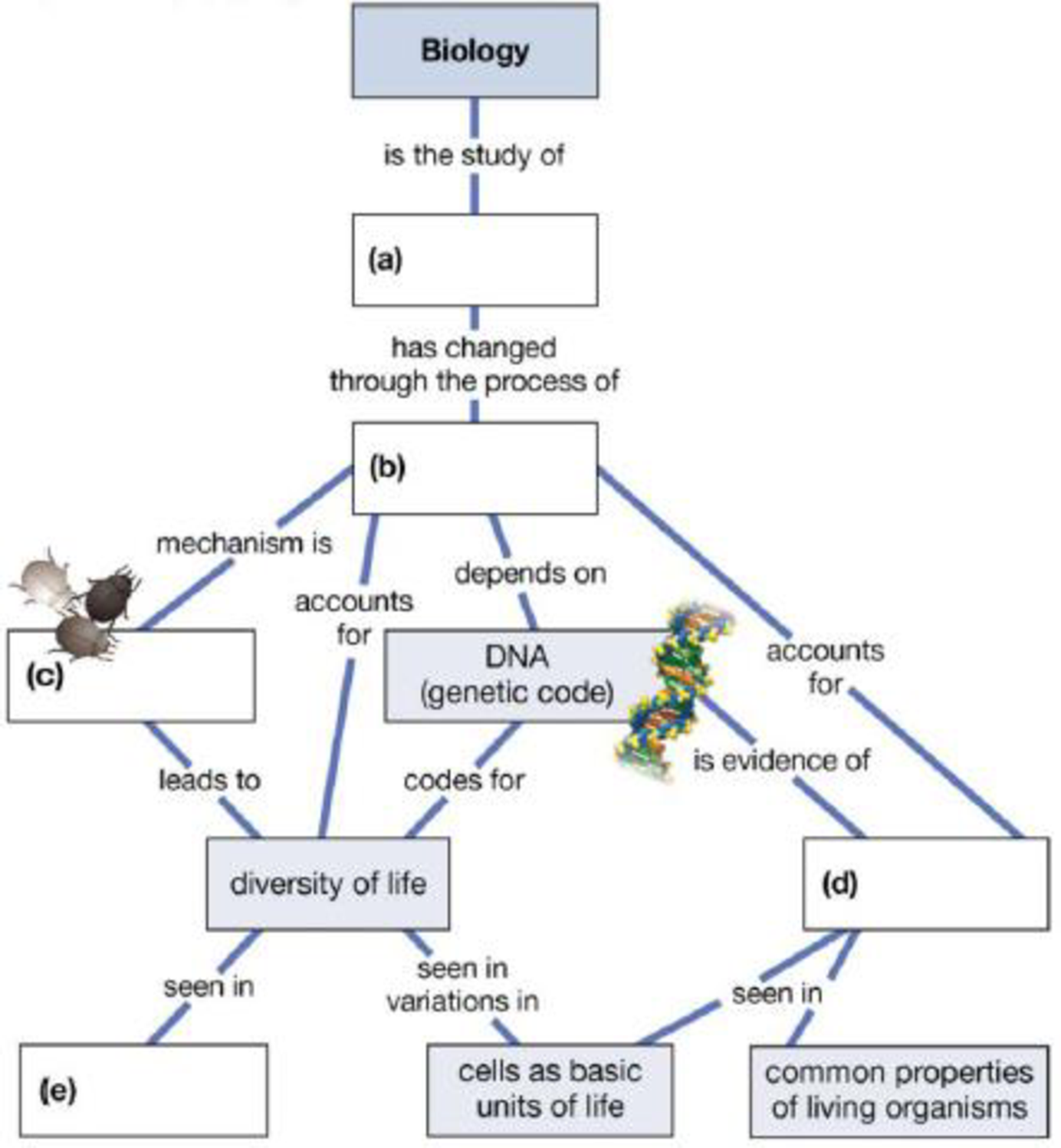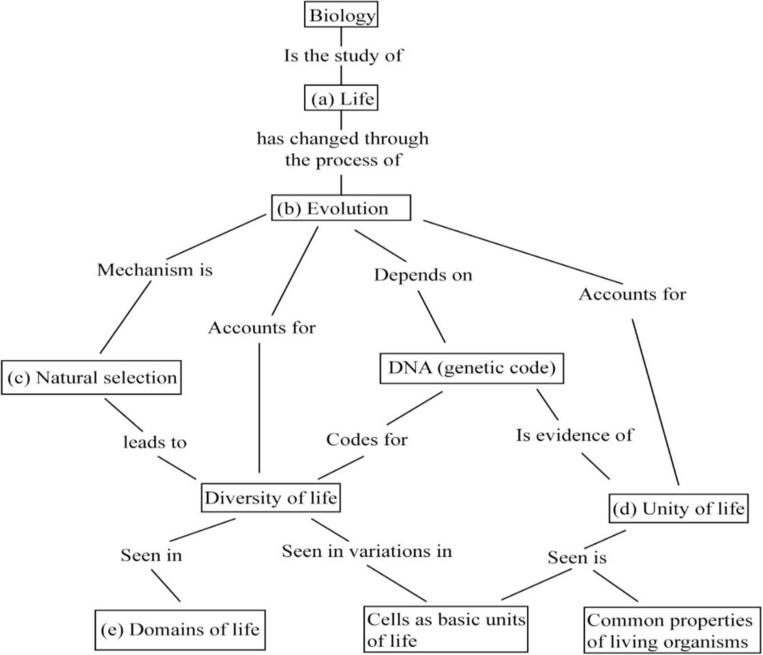
Concept explainers
Complete the following map organizing one of biology’s major themes.

To complete: The given map showing a major biological theme.
Introduction: The five major themes present in all biological systems are as follows:
Theme 1: “Evolution is the core theme of biology”.
Theme 2: “Life depends on the flow of information”.
Theme 3:“Structure and functions are related”.
Theme 4: “Life depends on the transfer and transformation of energy and matter”.
Theme 5: “Life depends on interactions within and between systems”.
Answer to Problem 1CC
Fig. 1 shows the completed map of evolution, one of the core themes in biology given in the textbook.
Pictorial representation: Fig. 1 shows the completed map of the core theme of biology: evolution.

Fig.1 Evolution as a core theme of biology
Explanation of Solution
(a)
Correct answer: Life
The term “biology” is defined as the branch of science that studies life (in Greek: bio= life; -ologia= study of). Hence, the correct answer is life.
(b)
Correct answer: Evolution
Evolution is defined as the continuous process of changes that have occurred over a long time to transform the living beings from their earliest simplest forms to the present-day wide variety of species. It can be summarized as “descent with modification”, that is, all species have evolved from common ancestors through several continuous changes over time. Thus, evolution is the process that has changed life. Hence, the correct answer is evolution.
(c)
Correct answer: Natural selection
Researcher Charles Darwin proposed the phenomenon of “natural selection” as the mechanism for evolution. In a large population of species, individuals show several variations in their traits; out of which, some variations are more favorable for survival, utilization of resources, and better reproductive success of selected individuals. This phenomenon of better adaptation, survival, and reproductive success of selected individuals due to the presence of certain traits or variations is called natural selection. These selected individuals are able to pass their traits to their next generation, and thus their population increases, slowly by transforming the population, leading to evolution. Thus, natural selection is the mechanism that drives evolution. Hence, the correct answer is natural selection.
(d)
Correct answer: Unity of life
Deoxyribonucleic acid (DNA) is present in most of the living organisms that help in the flow of information from one generation to the other and changes in which lead to evolution. Thus, it is a proof for unity among all life forms.
Evolution has led to the development of various species from a common ancestor through continuous changes. Thus, it shows unity among all life forms. Genetic code as DNA and evolution show unity of life. Hence, the correct answer is unity of life.
(e)
Correct answer: Domains of life
DNA that encodes the genetic information is present in most of the living organisms classified into various domains of life. There are a large number of organisms of various types from simple single-celled bacteria to highly complex and multicellular animals. The basis of their diversity is the genetic information coded in their genetic material, usually DNA. Differences in DNA sequences cause diversity among organisms belonging to different domains of life. Hence, the correct answer is domains of life.
Want to see more full solutions like this?
Chapter 1 Solutions
Campbell Biology Concepts and Connections, Third custom edition for Orange Coast College, Includes Online Access code.
- Which of the following best describes why it is difficult to develop antiviral drugs? Explain why. A. antiviral drugs are very difficult to develop andhave no side effects B. viruses are difficult to target because they usethe host cell’s enzymes and ribosomes tometabolize and replicate C. viruses are too small to be targeted by drugs D. viral infections usually clear up on their ownwith no problemsarrow_forwardThis question has 3 parts (A, B, & C), and is under the subject of Nutrition. Thank you!arrow_forwardThey got this question wrong the 2 previous times I uploaded it here, please make sure it's correvct this time.arrow_forward
- This question has multiple parts (A, B & C), and under the subject of Nutrition. Thank you!arrow_forwardCalculate the CFU/ml of a urine sample if 138 E. coli colonies were counted on a Nutrient Agar Plate when0.5 mls were plated on the NA plate from a 10-9 dilution tube. You must highlight and express your answerin scientific notatioarrow_forwardDon't copy off the other answer if there is anyarrow_forward
 Concepts of BiologyBiologyISBN:9781938168116Author:Samantha Fowler, Rebecca Roush, James WisePublisher:OpenStax College
Concepts of BiologyBiologyISBN:9781938168116Author:Samantha Fowler, Rebecca Roush, James WisePublisher:OpenStax College Human Biology (MindTap Course List)BiologyISBN:9781305112100Author:Cecie Starr, Beverly McMillanPublisher:Cengage LearningEssentials Health Info Management Principles/Prac...Health & NutritionISBN:9780357191651Author:BowiePublisher:Cengage
Human Biology (MindTap Course List)BiologyISBN:9781305112100Author:Cecie Starr, Beverly McMillanPublisher:Cengage LearningEssentials Health Info Management Principles/Prac...Health & NutritionISBN:9780357191651Author:BowiePublisher:Cengage Biology 2eBiologyISBN:9781947172517Author:Matthew Douglas, Jung Choi, Mary Ann ClarkPublisher:OpenStax
Biology 2eBiologyISBN:9781947172517Author:Matthew Douglas, Jung Choi, Mary Ann ClarkPublisher:OpenStax Biology Today and Tomorrow without Physiology (Mi...BiologyISBN:9781305117396Author:Cecie Starr, Christine Evers, Lisa StarrPublisher:Cengage Learning
Biology Today and Tomorrow without Physiology (Mi...BiologyISBN:9781305117396Author:Cecie Starr, Christine Evers, Lisa StarrPublisher:Cengage Learning





